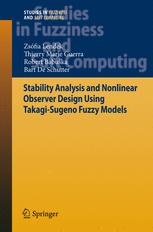

Most ebook files are in PDF format, so you can easily read them using various software such as Foxit Reader or directly on the Google Chrome browser.
Some ebook files are released by publishers in other formats such as .awz, .mobi, .epub, .fb2, etc. You may need to install specific software to read these formats on mobile/PC, such as Calibre.
Please read the tutorial at this link: https://ebookbell.com/faq
We offer FREE conversion to the popular formats you request; however, this may take some time. Therefore, right after payment, please email us, and we will try to provide the service as quickly as possible.
For some exceptional file formats or broken links (if any), please refrain from opening any disputes. Instead, email us first, and we will try to assist within a maximum of 6 hours.
EbookBell Team

4.1
60 reviewsMany problems in decision making, monitoring, fault detection, and control require the knowledge of state variables and time-varying parameters that are not directly measured by sensors. In such situations, observers, or estimators, can be employed that use the measured input and output signals along with a dynamic model of the system in order to estimate the unknown states or parameters. An essential requirement in designing an observer is to guarantee the convergence of the estimates to the true values or at least to a small neighborhood around the true values. However, for nonlinear, large-scale, or time-varying systems, the design and tuning of an observer is generally complicated and involves large computational costs.
This book provides a range of methods and tools to design observers for nonlinear systems represented by a special type of a dynamic nonlinear model - the Takagi-Sugeno (TS) fuzzy model. The TS model is a convex combination of affine linear models, which facilitates its stability analysis and observer design by using effective algorithms based on Lyapunov functions and linear matrix inequalities. Takagi-Sugeno models are known to be universal approximators and, in addition, a broad class of nonlinear systems can be exactly represented as a TS system. Three particular structures of large-scale TS models are considered: cascaded systems, distributed systems, and systems affected by unknown disturbances. The reader will find in-depth theoretic analysis accompanied by illustrative examples and simulations of real-world systems. Stability analysis of TS fuzzy systems is addressed in detail. The intended audience are graduate students and researchers both from academia and industry. For newcomers to the field, the book provides a concise introduction dynamic TS fuzzy models along with two methods to construct TS models for a given nonlinear system.
For additional information, see the book website at http://www.dcsc.tudelft.nl/fuzzybook/